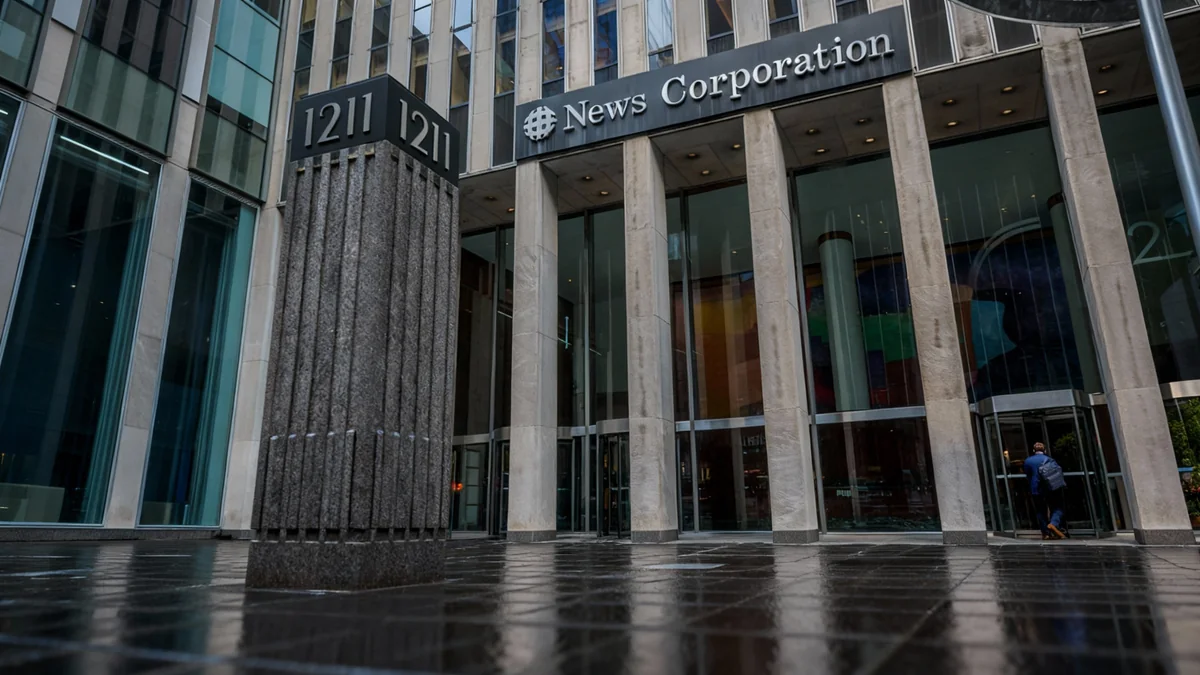News Corp has announced a strong start to its fiscal year, reporting increased revenue and profits for the first quarter. The growth was primarily fueled by robust performance in its Dow Jones and digital real estate divisions, which successfully counteracted a downturn in the company's book publishing segment.
The positive financial results highlight a successful strategic focus on digital subscriptions and high-value information services, positioning the media conglomerate favorably in a challenging market. Company leadership expressed confidence in its current trajectory and suggested its market valuation does not fully reflect its assets' strength.
Key Takeaways
- News Corp's revenue and profit increased in its fiscal first quarter.
- Growth was driven by the Dow Jones and digital real estate services divisions.
- The book publishing unit experienced a decline in performance.
- CEO Robert Thomson stated the company's shares are currently undervalued.
- The results indicate a successful pivot towards digital and professional information services.
Digital Divisions Drive Profitability
News Corp's first-quarter performance underscores a significant shift in its revenue streams, with digital-first segments leading the charge. The Dow Jones division, which includes The Wall Street Journal, Barron's, and MarketWatch, emerged as a key contributor to the company's financial health. This success points to a growing consumer appetite for trusted financial news and analysis, particularly in a volatile global economy.
The company has invested heavily in its digital subscription models, a strategy that appears to be yielding substantial returns. By focusing on high-quality, exclusive content, Dow Jones has managed to attract and retain a loyal subscriber base willing to pay for premium information.
Alongside the news division, the digital real estate services segment also posted significant gains. This unit, which includes platforms that connect buyers, sellers, and agents, has capitalized on the ongoing digitization of the property market. The performance of this division suggests that technology-driven real estate platforms remain a powerful and profitable business model.
A Mixed Picture Across Segments
While the digital and financial news units thrived, the story was different for News Corp's book publishing division. The segment, which includes major publisher HarperCollins, reported a drop in performance during the first quarter. This decline reflects broader challenges facing the traditional publishing industry, including shifting consumer habits and supply chain pressures.
The contrast between the high-flying digital units and the struggling publishing arm illustrates the strategic crossroads at which many legacy media companies find themselves. The ability to successfully manage this transition from traditional to digital revenue is a critical factor for long-term survival and growth.
The Power of Diversification
News Corp's varied portfolio, spanning news, real estate, and publishing, allows it to weather downturns in specific sectors. The strength of Dow Jones and digital real estate provided a crucial buffer against the weaker results from book publishing, demonstrating the value of a diversified business model in the modern media landscape.
The company's overall positive results, despite the dip in publishing, signal that its strategic priorities are well-placed. The focus on high-growth digital areas is effectively offsetting the cyclical or structural challenges faced by its more traditional businesses.
Leadership Signals Confidence in Market Value
In a call with analysts and investors following the earnings report, News Corp Chief Executive Robert Thomson conveyed a strong sense of optimism about the company's future. He directly addressed the company's stock performance, stating a belief that its current market valuation is not reflective of its true worth.
"We believe our shares are undervalued, given the sum of our valuable parts and our profit trajectory, and we will continue to focus on ways and means to maximize shareholder value."
This statement suggests that the company's leadership sees significant untapped potential in its assets. It may also signal potential future actions aimed at boosting shareholder value, such as strategic reviews, asset sales, or share buyback programs. Thomson's comments are a clear message to the market that the executive team is confident in its strategy and believes its growth story is just beginning.
Focus on Shareholder Value
Public statements about a company's stock being undervalued are often used to reassure investors and signal management's commitment. It highlights a focus on delivering returns and can sometimes precede strategic initiatives designed to unlock the perceived hidden value in the company's portfolio.
By emphasizing the "sum of our valuable parts," Thomson points to the strength of individual brands like The Wall Street Journal and the company's real estate portals. The strategy appears to be convincing investors to look beyond legacy segments and recognize the power of its digital and professional information engines.
Navigating the Future of Media
News Corp's first-quarter results offer a compelling case study in the evolution of a media giant. The success of its digital-centric divisions provides a roadmap for navigating a landscape where information is increasingly consumed and monetized online. The challenge remains in managing the transition for its legacy assets, like book publishing, to ensure they can adapt to new market realities.
The company's ability to grow profits in the current economic climate is a notable achievement. As advertisers and consumers tighten their belts, the demand for premium, indispensable information—whether financial news or real estate data—becomes even more pronounced.
Looking ahead, investors will be closely watching whether the growth in digital real estate and Dow Jones can be sustained and whether the company can stabilize its book publishing unit. The leadership's promise to maximize shareholder value will also be under scrutiny, with the market anticipating what steps might be taken to close the gap between its current share price and its perceived intrinsic worth.




